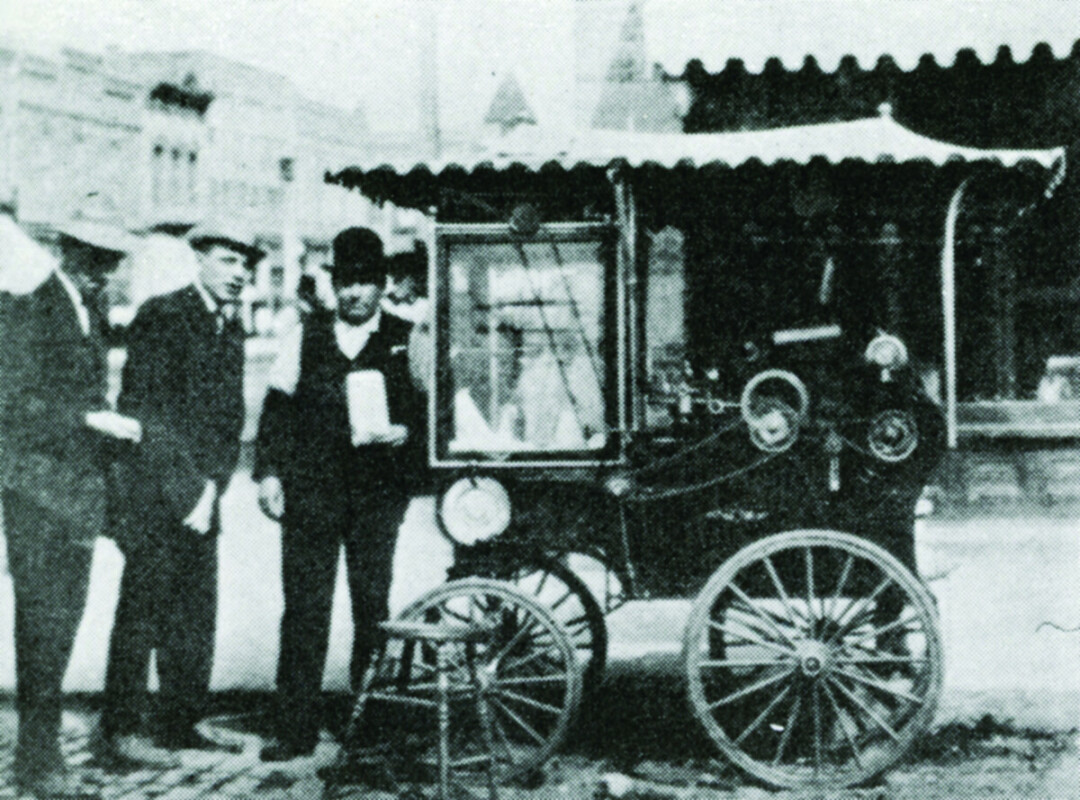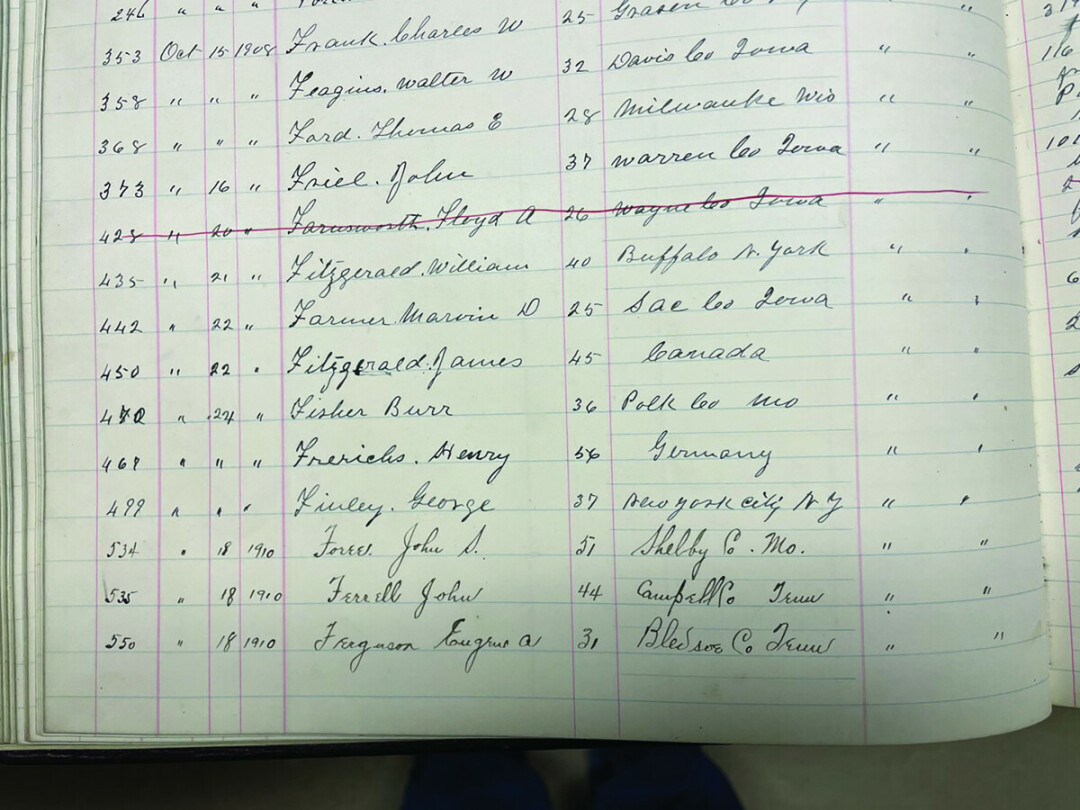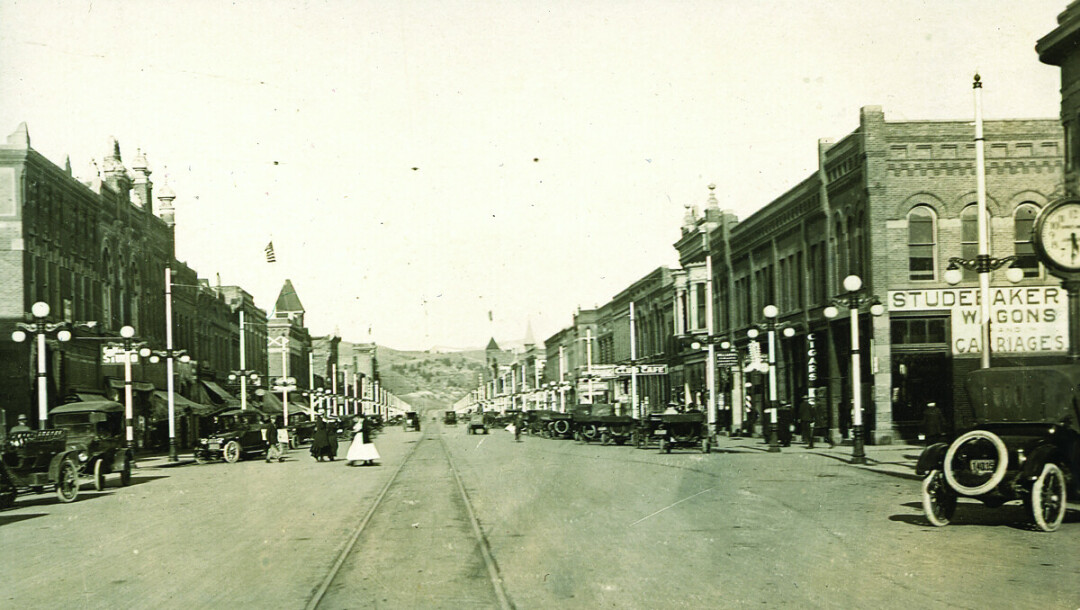In Search of Popcorn Johnnie
Rachel Phillips | Saturday Jul. 1st, 2023
The Gallatin History Museum research library contains thousands of family history files, photographs, records, newspapers, and books that pertain to the history of Gallatin County and southwest Montana. One of these books, Gallatin Century of Progress, was published in 1964 by the Gallatin Centennial Committee and serves as a good photographic history of the general area.
Among the many great images published in this volume is a small snapshot of three men posed next to an eye-catching popcorn wagon on Main Street in Bozeman. One of the men appears to be the wagon’s owner. He is dressed in a crisp white shirt, black vest and bowler hat, and is holding what looks like a paper popcorn bag. The caption under the image reads: “Popcorn Johnnie, a familiar figure to old time residents, who operated his little popcorn wagon at the corner of the present Miller’s Jewelry. Kids of the early 20s will remember Johnnie, who dispensed large portions of delicious popcorn for 5c a bag. Though many believed Johnnie to be penniless, when he died he had an estate of some $16,000.”
This is an interesting tidbit, but who exactly was Popcorn Johnnie? No other information about this man was given. My initial quick check in the Museum’s collection of family files revealed one folder titled “Popcorn Johnnie” that contained a single undated and unidentified newspaper clipping. The text was brief, nearly identical to what was published with the popcorn wagon photograph in Gallatin Century of Progress. Unfortunately, it provided no additional clues. Now on a quest to test my detective skills and uncover Popcorn Johnnie’s true identity, I decided to delve deeper and find out how much I could discover.
The obvious first step was to uncover Johnnie’s full name. Polk City Directories are an excellent tool for finding individuals in a community and are a convenient starting place. Bozeman directories were published most years beginning in 1892-1893, and list community residents, addresses and occupations. They also include businesses arranged alphabetically by type in a section similar to the yellow pages in a phone book. The Gallatin History Museum research library maintains a collection of directories that range from 1892 to 2012.
I assumed that the caption beneath the photo was correct – that Popcorn Johnnie was active in Bozeman in the 1920s. Unfortunately, the 1922, 1925, and 1929 directories did not contain a business category for “Popcorn” or “Peddlers.” I traveled further back in time to the 1914-1915 directory. To my astonishment, a heading for “Popcorn” appeared in the business section between “Pool Halls” and “Portraits.” Two names were listed there: Edward Clare, and John Ferrell. Of the two names, John Ferrell seemed the logical choice to pursue, considering my subject’s nickname was “Johnnie.”
The 1912-1913 city directory listed only one popcorn vendor – John Ferrell. His occupation simply stated “popcorn wagon,” and it seemed possible that this was the famous “Popcorn Johnnie.” My next question became: When did John Ferrell arrive in Bozeman? Additional searching revealed that he first appeared in the city directory in 1910, with the words “pop corn” printed after his name. John Ferrell was not listed in the 1908 volume, and no directory was published in 1909. However, I located another source that suggested Ferrell had arrived in Bozeman by 1908.
Voter registration records are a valuable tool for tracing early Bozeman residents, and they can add to information gleaned from city directories. Early voter records often include a subject’s age, birthplace, and the general area of town in which they lived. The handwritten Gallatin County voter registration ledger books in the museum archives cover the years 1889 through 1910. John Ferrell’s name appeared as a registered Gallatin County voter in 1908 and 1910.
The 1908 entry listed Ferrell’s age as 42, and birthplace as Tennessee. Like many other early voter registration entries in Gallatin County, Ferrell’s home address is vague and simply reads “Bozeman Ave. S.” The 1910 record listed his age as 44 and his birthplace as Campbell County, Tennessee. The entry further recorded his home as a “frame house” at 106 North Bozeman. Now I was getting somewhere.
Another search through Bozeman city directories revealed that Ferrell worked as a popcorn vendor from at least 1910 through 1927. During those years, his occupation was described using terms like “popcorn,” “popcorn wagon,” or “peddler.” According to the one short paragraph written about Popcorn Johnnie in Gallatin Century of Progress, he “operated his little popcorn wagon at the corner of the present Miller’s Jewelry.” When the book was published in 1964, Miller’s Jewelry was located at 2 East Main Street (the southeast corner of Main and Tracy). A close examination of the accompanying image revealed that it was taken very near the intersection of Main and Tracy. Several buildings on the north side of Main Street are visible behind the popcorn wagon. One is the beautiful structure at 29 East Main Street, currently occupied by Plonk.
U.S. Census data places John Ferrell in Bozeman in 1930 and 1940. Census records add a few more details about Ferrell, and help to confirm his birth circa 1866 in Tennessee. According to the census, he did not attend school past the 5th grade, and lived alone. He must have liked the local people and his chosen profession, as he spent nearly forty years in Bozeman. His name appeared in the city directories through 1947, spelled both “Ferrell” and “Farrell.” From 1922 through 1947, John’s home address was 301 E. Mendenhall Street. The only exception to this appeared in 1933, when he resided on “Bridger Rd.” For one year in 1931, Ferrell’s occupation was listed as “rancher.” This suggests he retired his popcorn wagon sometime in the late 1920s and tried his hand at agriculture, possibly on land north of town near today’s Bridger Drive.
The house at 301 East Mendenhall Street no longer exists. For several decades, it graced the north side of Mendenhall, just west of Bozeman Creek. Sanborn Fire Insurance maps in the Museum’s collection indicate the home was constructed in the late 1890s or early 1900s, certainly by 1904. The house was enlarged several times in subsequent decades, likely by Mr. Ferrell himself. Midwest Welding and Machine used the house as office space in the late 1950s, while the shop itself was on the east side of Bozeman Creek across Rouse Avenue from Hawthorne School. Today, a parking lot covers the ground previously occupied by John Ferrell’s house.
Ferrell disappeared from the city directories after 1947. By this time, he was likely over eighty years old. I wondered if he may have moved to a warmer climate, or to be closer to family. An online search eventually yielded a Missouri death certificate and an obituary for a man named John Ferrell who passed away in July 1949, and who previously resided in Montana. According to the Greene County, Missouri death certificate, this John Ferrell was a retired merchant, born in Tennessee on January 6, 1866. He passed away at age 83 on July 11, 1949, a victim of arteriosclerosis, hypertension, and cerebral thrombosis. He was buried in Smith Cemetery in Greene County, Missouri.
The obituary for this particular John Ferrell was printed in the Springfield Leader and Press and reads: “John Ferrell, 83, retired merchant who formerly lived at Rogersville, died this morning in Springfield Baptist hospital after a long illness. During recent years he had lived in Montana but returned to Springfield 15 months ago, where he stayed in a rest home. Surviving are his brother, Amos Ferrell of Bloom, Kan., four nephews and one niece...”
Could this be Bozeman’s Popcorn Johnnie? There is a good possibility, but more research is required to be certain. Also, what about the mention in Gallatin Century of Progress of Johnnie’s mysterious $16,000 estate? This would be the equivalent of approximately $204,000 today. No additional information about this small fortune has emerged thus far, so perhaps it was simply a rumor. Or maybe Johnnie struck gold — at least the light, fluffy, buttery kind.
| Tweet |
